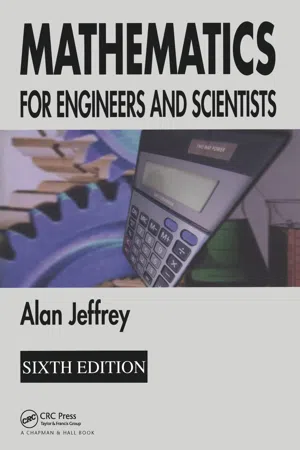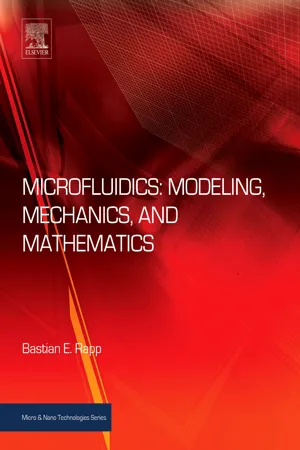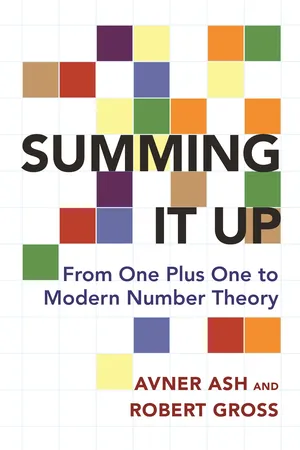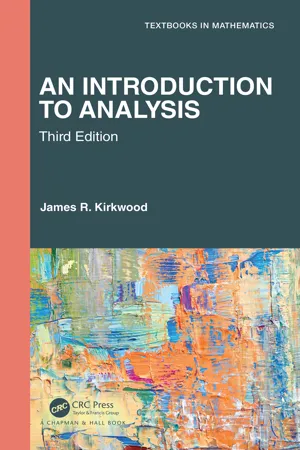Mathematics
Series Maths
In mathematics, a series is the sum of the terms of a sequence. It is often represented using sigma notation and can be finite or infinite. The study of series involves understanding convergence, divergence, and methods for finding the sum of a series, such as using formulas or techniques like telescoping.
Written by Perlego with AI-assistance
Related key terms
8 Key excerpts on "Series Maths"
- eBook - ePub
- Joseph D. Fehribach(Author)
- 2023(Publication Date)
- De Gruyter(Publisher)
3 Infinite series in ℝOne of the reasons for studying sequences in the context of calculus is that they are needed to define and study series. The notation for a series is∑k = 1∞a k,where, as was the case for our sequences,. As this notation suggests, the idea of a series is that it is a sort of infinite sum. There is, however, a problem with this view: What does it mean to add together an infinite number of real numbers? That it is difficult (or maybe impossible) to work directly with an infinite sum leads to infinite series being defined as something that we do know how to work with—as the limit of a sequence.a k∈ RDefinition.
Consider the sequence{. The partial sums for this sequence are defined asa k} ⊂ RA n: =∑k = 1na k≡a 1+a 2+a 3+ ⋯ +a n,that is,A nis the finite sum of the first n elements of the sequence{. Notice thata k}{is itself a sequence. An infinite series (or simply a series) of real numbers is defined as the limit of the sequence of partial sums:A n}∑k = 1∞a k: =limn → ∞A n≡limn → ∞∑k = 1na k,where again. A series converges or diverges as its sequence of partial sums converges or diverges.a k∈ RRemarks.
1.Almost every result we prove below about series uses this definition of series as the limit of the sequence of partial sums. This is the key definition for our work in this chapter.2.In calculus, the most important series are series of functions including power series. For this chapter, however, we will only consider series where the termsa kare real numbers. Series of functions and power series are discussed in Chapter 4 - eBook - ePub
Approximating Perfection
A Mathematician's Journey into the World of Mechanics
- Leonid P. Lebedev, Michael J. Cloud(Authors)
- 2015(Publication Date)
- Princeton University Press(Publisher)
A series is an “infinite sum,” commonly denoted as which simply means that we must perform the addition step by step to infinity. It is clear that this involves a limit passage. Elementary math students are frightened of series, sometimes refusing to believe that any infinite sum of positive numbers could turn out to be finite. The ancient mathematician-philosophers expressed similar reservations: the famous Zeno (c. 495–430 B.C.), while considering the nature of space and motion, constructed a well-known paradox about the swift runner Achilles, who could never catch a turtle. The proof was as follows. Between Achilles and the turtle, there is some distance. By the time Achilles covers this distance, the turtle has moved ahead by some distance. By the time Achilles covers this new distance, the turtle has moved ahead by yet another distance. The resulting process of trying to catch the turtle never ends. For Zeno, it was evident that a sum of finite positive quantities must be infinite, which meant that the time necessary for Achilles to catch the turtle must be infinite. Here, Zeno was led to consider a sum of time periods of the form which, again, he regarded as obviously infinite. We shall see that certain sums of this type are infinite, but others can be interpreted in a limit sense. The latter are useful in practice. A common but sometimes overlooked example is the ordinary decimal representation of the number π : This can be viewed as the infinite sum We have all used some approximation of π, truncating the series somewhere (usually at 3.14) with full awareness that we would have to include “all of the terms” to get the “exact result.” So in some sense it must be possible to “sum” an infinite number of terms and obtain a finite answer. (The Greeks did not have a positional notation for decimal numbers, hence this argument would probably not have convinced them - eBook - ePub
- Alan Jeffrey(Author)
- 2004(Publication Date)
- Chapman and Hall/CRC(Publisher)
+ … is a series.If a sequence is composed of elements or terms u belonging to some set S , then it is conventional to indicate their order by adding a numerical suffix to each term. Consecutive terms in the sequence are usually numbered sequentially, starting from unity, so that the first few terms of a sequence involving u would be denoted by u 1 , u 2 , u 3 ,… . Rather than write out a number of terms in this manner this sequence is often represented by {un}, whereunis the n th term, or general term, of the sequence. The sequence depends on the set chosen for S and the way suffixes are allocated to elements of S . A sequence will be said to be infinite or finite according to whether the number of terms it contains is infinite or finite and, unless explicitly stated, all sequences will be assumed to be infinite. The notation for a sequence is often modified towhen only a finite number N of terms are involved, so that{u n}n = 1N.={u n}n = 1Nu 1,u 2, … ,u NAs an example of an infinite numerical sequence, let S be the set of real numbers and the rule by which suffixes are allocated be that to each integer suffix n we allocate the number 1/2n which belongs to R . We thus arrive at the finite sequence u 1 = 1/2, u 2 = 1/22 , u 3 = 1/23 - Bastian E. Rapp(Author)
- 2016(Publication Date)
- Elsevier(Publisher)
Chapter 4Series
4.1 Introduction
4.1.1 Definition
In general a seriessnis defined as a sum of a given number of termsaisuch thats n=a 1+a 2+ . . .a n=∑i = 1na iIf n = ∞ , the series is said to be infinite series . If n is finite, it is said to be a finite series .4.1.2 Convergence
In most practical applications, a series will have to be evaluated up to a given upper bound n . The higher this bound is chosen, the more exact the solution, but also the more time-consuming, complicated and computationally expensive the solution will become. Therefore a suitable trade-off for n must be found.However, some of the more important series actually sum up to a defined value. In such cases a series is said to be a convergent series . Obviously, convergent series are significantly easier to use as they can simply be replaced by the convergence value . The convergence value s is defined ass =limn → ∞∑i = 1na iCertain criteria can be used in order to test whether a series converges.Ratio Test. The ratio test checks iflimx → ∞|= q|an + 1a nIf q < 1, the series converges; for q > 1, the series diverges. For q = n , the test is inconclusive, i.e. , it makes no statement about whether or not the series converges.Root Test. The root test checks iflimnx → ∞|= qa n|For q < 1, the series converges; for q > 1, the series diverges. For q = n , the test is inconclusive, i.e. , it makes no statement about whether or not the series converges.Other Tests. Additional tests can be used to test a series for convergence. The interested reader may refer to standard textbooks on engineering mathematics for more details.4.1.3 Important Series
In the following sections, we will occasionally have to evaluate series. The most important ones are summarized in Tab. 4.1 together with their convergence values.Tab. 4.1- eBook - ePub
Summing It Up
From One Plus One to Modern Number Theory
- Avner Ash, Robert Gross(Authors)
- 2016(Publication Date)
- Princeton University Press(Publisher)
PART TWOInfinite SumsPassage contains an image
Chapter 7INFINITE SERIESFrom now on, we assume that you are familiar with the concept of limit from calculus. Although the subject of this chapter is infinite series, which refers to sums of infinitely many numbers or terms, we will begin with a finite sum of a particular sort.1. Finite Geometric SeriesIf we add up some consecutive powers of a, we get a geometric series. In greatest generality, a finite geometric series looks likewith nonzero constants a and c and integers m ≤ n. We say this geometric series “has ratio a.” There is a nice formula for this sum:One way to remember this formula is to say that the sum of a finite geometric series equals the first term minus “the term that is one past the last term,” all divided by one minus the ratio. This formula only works if a ≠ 1. (When a = 1, you don’t really need any formula.)Why is the formula true? Let ThenSubtract aS from S, and all of the inside terms cancel. We getBut we can rewrite the left-hand side of this equation asNow, divide both sides by 1 – a, and we getMultiply both sides by cam , and you get (7.1 ).For example, we can easily sum up the powers of 2:So the sum is one less than the next power of 2. Notice that this sum grows without bound as n increases.We can just as easily sum up the powers of :This sum does have a limit as n increases, namely 1. This limiting behavior is related to one of Zeno’s paradoxes. If you try to exit a room, first you have to go halfway to the door, then half of the remaining distance (which is a distance of one-quarter of the way to the door), and so on. Thus you can never actually get out of the room. Our sum shows that after n “steps” of this “process,” you will still have a distance to go of 1/2nof the distance you had to begin with. The “solution” to the paradox is that this is an infinite process that you can actually complete by letting n go to infinity, at which time you will have gone the whole distance, since - eBook - ePub
- Richard Johnsonbaugh, W.E. Pfaffenberger(Authors)
- 2012(Publication Date)
- Dover Publications(Publisher)
V
Infinite SeriesThe present chapter can be viewed as an extension of the ideas developed in Chapter IV on sequences. Infinite series play an important theoretical and practical role in analysis.22. The Sum of an Infinite Series
In order to sum an infinite sequence of real numbers we must employ the notion of limit. We begin with the definition of an infinite series.Definition 22.1 Let {an} be a sequence. For each positive integer n, letAn infinite series is the ordered pair of sequences ({an}, {sn}).The number anis called the nth term of the infinite series, and the number snis called the nth partial sum of the infinite series. Instead of using the cumbersome ordered pair notation for an infinite series, we will use the notationto represent an infinite series. It should be understood that the symbolism an denotes two sequences, namely the sequence {an} of terms of the infinite series and the sequence {sn} of partial sums of the infinite series.It is important to distinguish between the sequence {an} of terms and the sequence {sn} of partial sums of an infinite series an> . We illustrate this with an example. For the infinite series ,(−1)n we have an= (− 1)nandThe sequence {(− 1)2n} is a subsequence of {(− 1)n}. The nth term of the series ,(−1)2n is 1, and the nth partial sum of this series is tn= n for n = 1, 2, . . . . Notice that although {(− 1)2n} is a subsequence of {(− 1)n}, {tn} bears little resemblance to {sn}.Sometimes it is convenient to begin the index of an infinite series with an integer other than 1. For example, we may consider the series a0 or, in general, an where p is an integer. The sequence of partial sums as defined in Definition 22.1 will be altered in the obvious way.To sum an infinite series, we simply add on more and more “terms.” This corresponds to taking the limit of the sequence of partial sums. We make this notion precise in the following definition. - eBook - ePub
- Seymour B. Elk(Author)
- 2016(Publication Date)
- Bentham Science Publishers(Publisher)
n , is of major interest in the evolution of the concept “what is mathematics?”, the addition of successive individual terms, called a “series” is of even greater utility. Given such a sequence, attention may be focused on the corresponding series:s1 = a1 ; s2 = a1 + a2 , …, sn = a1 + a2 + …. + an .Moreover, when there are an infinite number of such terms added together, this sum, referred to as an “infinite series” will be shown to be the basis for re-defining many of the important functions of arithmetic, algebra, trigonometry and calculus. In the same manner as attention was focused on selected reference sequences, an examination of the corresponding series is in order:The single element sequence, which may be regarded as the identity sequence, superficially appears to have little to no utilitarian function in mathematics; however, the single element series (1 + 1 + 1 +…) is of paramount importance as the basis of a counting system; namely, this series produces the sequence of numbers 1, 2, 3, etc. This latter sequence serves as the upper bound for determining whether a given series will “converge” (sum up to a finite number and thus be of utilitarian value) or “diverge” (sum to infinity and only be of interest in theoretical mathematics). Moreover, one shall find significant utility ONLY in those series that converge to a single finite number.Comparable to building a library of useful graphs in Chapter 2, in this chapter a library of convergent and divergent infinite series will be built that serves as a means for determining whether a given series converges or diverges. In this endeavor, special attention is paid to two extreme series:(1) The above described single element function whose numerical value is ∞. Call it S1(2) The geometric progression learned in algebra course whose numerical value, call it S2 , is equal to:(1) where a is the first term, n is the number of terms in a finite series or ∞ otherwise and r is the ratio of successive terms: . This series bears a strong relation to the race between Achilles and the turtle at the beginning of Section 2.2. This is especially true when - eBook - ePub
- James R. Kirkwood(Author)
- 2021(Publication Date)
- Chapman and Hall/CRC(Publisher)
7 Series of Real Numbers 7.1 Tests for Convergence of Series In this chapter we consider series of real numbers, a topic that is intimately related to sequences of real numbers. What one would like to do in a series is to add an infinite number of numbers. We begin with a sequence { a n }, that consists of the numbers we want to sum. From { a n } we construct a new sequence { S n } as follows: Let S 1 = a 1 S 2 = a 1 + a 2 ⋮ S k = a 1 + a 2 + ⋯ + a k. Thus { S k } is the sum of the first k terms of the sequence { a n }. Notice that S k − S k − 1 = a k for k > 1. Definition: A series ∑ n = 1 ∞ a n is defined as the ordered pair of sequences ({ a n }, { S n }) where the sequences are related as above. Definition: Let { a n } and { S n } be the sequences above. Then { S n } is called the sequence of partial sums for the series ∑ n = 1 ∞ a n. The numbers a n are called the terms of the series ∑ n = 1 ∞ a n. Definition: We say the series ∑ n = 1 ∞ a n converges to L if the sequence of partial sums converges to L and we say the series ∑ n = 1 ∞ a n diverges if the sequence of partial sums diverges. We say the series ∑ n = 1 ∞ a n diverges to ∞ or − ∞ if the sequence of partial sums does so. Notice that since S n = ∑ i = 1 n a i then lim n → ∞ S n = lim n → ∞ ∑ i = 1 n a i and we shall sometimes write ∑ i = 1 ∞ a i = lim n → ∞ ∑ i = 1 n a i. For compactness of notation, we shall often write ∑ a n for ∑ n = 1 ∞ a n. It is very important to understand that the question of convergence or divergence of a series is exactly the same question as convergence or divergence of the sequence of partial sums for the series. This means we can apply the results of Chapter 2 in determining properties of series. An illustration of this is given by the proof of Theorem 7.1. Theorem 7.1: Suppose that the series ∑ a n converges to a and the series ∑ b n converges to b. Then for any numbers α and β the series ∑ (α a n + β b n) converges to α a + β b
Index pages curate the most relevant extracts from our library of academic textbooks. They’ve been created using an in-house natural language model (NLM), each adding context and meaning to key research topics.







